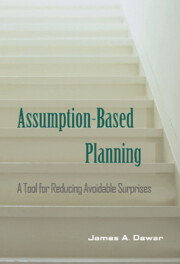Book contents
- Frontmatter
- Contents
- Figures
- Preface
- Acknowledgments
- 1 The essence of Assumption-Based Planning
- 2 A taxonomy of assumptions
- 3 Step 1: identifying assumptions
- 4 Step 2: identifying load-bearing, vulnerable assumptions
- 5 Step 3: identifying signposts
- 6 Step 4: developing shaping actions
- 7 Step 5: developing hedging actions
- 8 The art of conducting ABP
- 9 Beyond ABP as a post-planning tool
- Appendix: Assumption-Based Planning and the planning literature
- Bibliography
- Glossary
- Index
9 - Beyond ABP as a post-planning tool
Published online by Cambridge University Press: 29 October 2009
- Frontmatter
- Contents
- Figures
- Preface
- Acknowledgments
- 1 The essence of Assumption-Based Planning
- 2 A taxonomy of assumptions
- 3 Step 1: identifying assumptions
- 4 Step 2: identifying load-bearing, vulnerable assumptions
- 5 Step 3: identifying signposts
- 6 Step 4: developing shaping actions
- 7 Step 5: developing hedging actions
- 8 The art of conducting ABP
- 9 Beyond ABP as a post-planning tool
- Appendix: Assumption-Based Planning and the planning literature
- Bibliography
- Glossary
- Index
Summary
This book has described a relatively narrow niche for Assumption- Based Planning: as a post-planning tool for testing and improving plans. In our experiences with ABP in a variety of planning situations, we have come to appreciate, somewhat paradoxically, both the utility in circumscribing the role of ABP and the broader utility that can come from paying attention to one's assumptions in planning. This chapter concentrates on the latter.
The broader utility of paying attention to assumptions in planning has two aspects: (1) ABP as a tool can be useful during the planning process as well as after, and (2) assumptions can receive attention apart from a formal application of ABP—in Assumption-Based Thinking. However, before I delve into these two aspects, I want to address why we have worked so hard, up to now, in circumscribing the role of ABP.
The two basic reasons for circumscribing the applicability and utility of ABP are
to avoid overselling ABP
to emphasize when ABP is most useful.
Assumption-Based Planning is not a planning methodology. That is, it is not useful for planning from scratch. It omits too important an ingredient—the world that planners might consider “most likely,” the world of no broken assumptions—to be a complete planning methodology. This omission is purposeful. The world of no broken assumptions is more likely to be a distraction than an aid in thinking about the uncertainties of the future.
- Type
- Chapter
- Information
- Assumption-Based PlanningA Tool for Reducing Avoidable Surprises, pp. 172 - 184Publisher: Cambridge University PressPrint publication year: 2002

